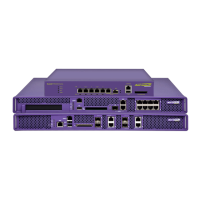Controller Services
Summit WM3000 Series Controller System Reference Guide266
synchronization packets within a network. To listen to NTP broadcast traffic, the broadcast server
(and controller) must be on the same subnet. NTP broadcasts reduce configuration complexity since
both the controller and its NTP resources can be configured to send and receive broadcast messages.
If this checkbox is selected, the AutoKey Authentication checkbox is disabled, and the controller is required to
use Symmetric Key Authentication for credential verification with its NTP resource. Additionally, if this option is
selected, the broadcast server cannot be selected as a preferred source.
7 Enter the IP Address of the peer or server providing SNTP synchronization.
8 Select the Hostname checkbox to assign a hostname to the server or peer for further differentiation of
other devices with a similar configuration.
9 Use the NTP Version drop-down menu to select the version of SNTP to use with this configuration
Currently version three and version four implementations of NTP are available. The latest version is
NTPv4, but the official Internet standard is NTPv3.
10 If necessary, select the No Authentication checkbox to allow communications with the NTP resource
without any form of security. This option should only be used with known NTP resources.
11 Select the AutoKey Authentication checkbox to use an Auto key protocol based on the public key
infrastructure (PKI) algorithm. The SNTP server uses a fast algorithm and a private value to
regenerate key information on the arrival of a message. The controller sends its designated public
key to the server for credential verification and the two exchange messages. This option is disabled
when the Broadcast Server checkbox is selected.
12 Select the Symmetric Key Authentication checkbox to use a single (symmetric) key for encryption and
decryption. Since both the sender and the receiver must know the same key, it is also referred to as
shared key cryptography. The key can only be known by the sender and receiver to maintain secure
transmissions.
13 Enter an Key ID between 1-65534. The Key ID is a Key abbreviation allowing the controller to
reference multiple passwords.
14 Select the Preferred Source checkbox if this NTP resource is a preferred NTP resource. Preferred
sources are contacted before non-preferred resources. There can be more than one preferred source.
15 Refer to the Status field. The Status is the current state of the requests made from the applet.
Requests are any “SET/GET” operation from the applet. The Status field displays error messages if
something goes wrong in the transaction between the applet and the controller.
16 Click OK to save and add the changes to the running configuration and close the dialog.
17 Click Cancel to close the dialog without committing updates to the running configuration.
Viewing NTP Associations
The interaction between the controller and a SNTP server constitutes an association. SNTP associations
can be either a peer association (the controller synchronizes to the another system or allows another
system to synchronize to it), or a server association (only the controller synchronizes to the SNTP
resource, not the other way around).
To review the controller’s current SNTP associations:
1 Select Services > Secure NTP from the main menu tree.
2 Select the NTP Associations tab.

